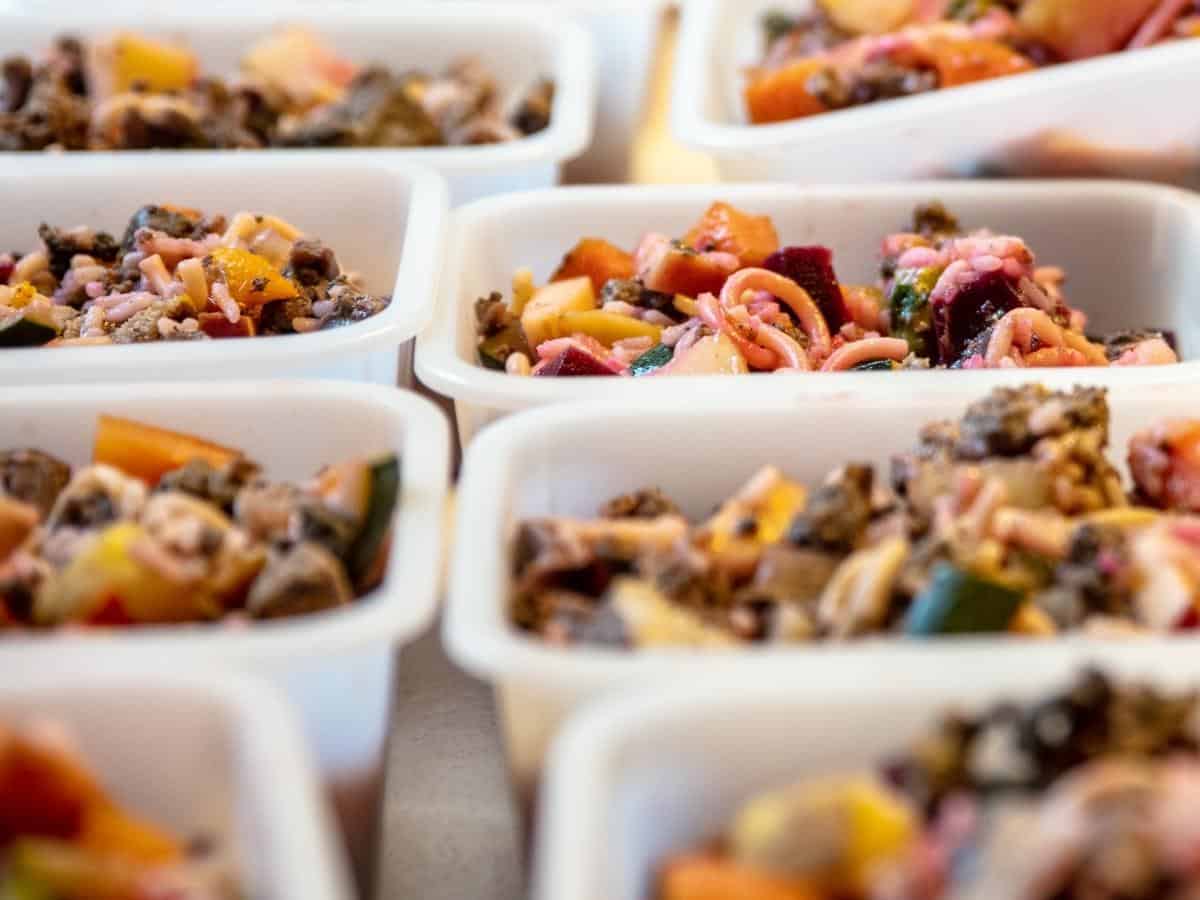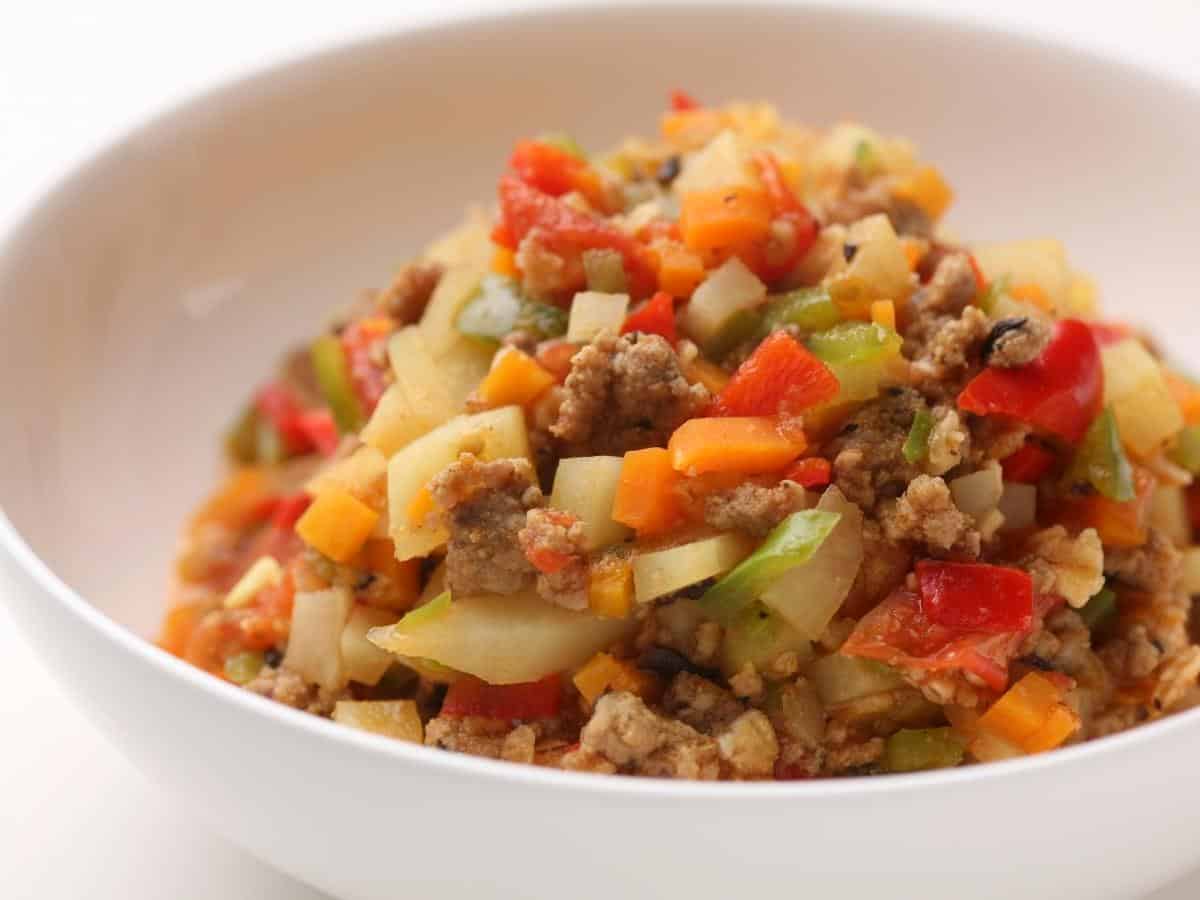Making your own dog food is not the most common practice when it comes to feeding your pet.
While health and distrust in the quality of commercial food are the main reasons dog owners decide to make their own dog food, switching to homemade food is often deferred for cost constraints.
So, is it cheaper to make your own dog food? From my research, here’s what I found:
Homemade dog food is more expensive than dry kibble but less expensive than human-grade commercial options. A $25 bag of kibble lasts a week, while homemade meals can cost about $10 daily, depending on your dog’s size and ingredient prices.
In this post, we’ll explore the financial aspects of homemade versus store-bought dog food, considering factors like ingredient costs, nutritional value, and the size and dietary needs of your dog.
Whether you’re a budget-conscious pet parent or simply curious about the economics of dog food, join us as we unpack the true cost of feeding your four-legged friend.
Let’s crunch the numbers!

Is It Cheaper to Make Your Own Dog Food?
A recent study found that only 13% of dog owners exclusively fed their pets homemade food. But why is this?
Let’s investigate the data!
Going by available literature and research on the cost of homemade and commercial dog food options, making your own dog food comes with higher costs than opting for commercial diets.
- According to the VCA Animal Hospitals, you’ll pay more to make homemade dog diets than to purchase commercial ones.
- Similarly, a study conducted in collaboration with the American Veterinary Medical Association reported that making your own dog food at home is generally more expensive. Besides, it is more time-consuming and inconvenient to prepare.
The only time homemade dog food would come cheaper is when compared to commercial human-grade diets.
- A study in Brazil that compared the cost of homemade, dry, and canned dog food and commercial human-grade food found that making homemade dog food was more costly than buying commercial kibble or canned food. However, making your own dog food is cheaper than purchasing commercial human-grade dog food.
So, why exactly is making your own dog food more costly than buying commercial kibble or canned dog food? Let’s tackle that question in the next section.

What Makes Homemade Dog Food Costly?
Cost can take different connotations. It could account for the buck you pay to obtain your dog’s food, the time you put into it, and other hidden costs that could arise from a specific dog food option.
In this light, I found that homemade dog food is more costly for the following reasons:
- Homemade dog food ingredients are costly.
- Making your own dog food is time-consuming.
- Homemade dog food is often under-nourishing.
Expensive Ingredients
Every type of dog food comes with a cost, whether it is commercial or homemade dog food. The main reason dog food prices increase is the cost of the ingredients.
Dog food ingredients should be combined to provide all the nutrients for your dog’s wellness. Ensuring proper nutrition for your dog means making sure that homemade dog food has all the required ingredients as listed:
- Proteins – Obtained from meats like chicken, beef, turkey, and fish such as salmon and whitefish.
- Carbohydrates – From starches like white/brown rice, oatmeal, potatoes, sweet potatoes, and quinoa.
- Vitamins – including vitamin A from carrots and pumpkins; Vitamin B from whole grains, green vegetables, and liver; Vitamin C from fruits like apples and watermelon, blueberries, and bananas; Vitamin D from meats and fishes; Vitamin E from plant oils and leafy green vegetables; and Vitamin K from vegetables and fish.
- Fats & fatty acids – From animal or plant seed oils such as canola, corn, fish, soybean, and flaxseed.
- Fiber – Important for gastrointestinal (GI) healthy functioning. Sources include green leafy vegetables, brown rice, apples, carrots, and flaxseeds.
- Minerals – including Calcium from broccoli, tofu, and green beans; Sulfur from meats and fishes; Magnesium from vegetables and whole grains; Iron from meat; Zinc from eggs, liver, and lamb; Iodine from seafood and kelp; Selenium from brown rice, meats, and vegetables; and Copper from whole grains, seafood, and seeds.
- Water – An important ingredient in a healthy dog diet.
While all these ingredients are cheaper incorporated in the dough that makes commercial kibble, purchasing these ingredients for a daily dog home diet is costly.

Let’s take an example from a sample recipe for a day’s meal for a 20lb dog:
| Sample Recipe Ingredients | Cost |
| ¼lb skinless chicken | $0.924 |
| 1 cup brown rice | $1.826 |
| 1 cup peas & carrots | $1.06 + $1.39 = $2.45 |
| ¼ teaspoon Potassium chloride (salt substitute) | |
| 1 teaspoon vegetable oil | |
| Vitamin/mineral supplement | |
| Total Cost | $5.19 |
Note: The prices are calculated from the price rates provided on different websites at the time of writing this article: (U.S. BUREAU OF LABOR STATISTICS (Chicken and rice), Statista (carrots), & Produce Market Guide (peas).
By these calculations that only factor in the main ingredients (chicken, rice, peas, and carrots), you will pay approximately $5.19 to feed your 20lb (9kg) dog with homemade food daily.
If you double the ingredients amount for a 40lb (18kg) dog, it means $10.38 daily and even more if you have a larger dog.
If you compare this cost with a commercial equivalent, such as Purina ONE Dry Dog Food, with the lowest price of around $25, you’ll pay a lot less, as the 8lb (3kg) bag can feed your dog for an entire week.
The Time Investment
If you feed your dog with kibble or canned food, you can simply sit on your couch, use your phone to make an order and have the dog food delivered to your doorstep. You can then pour the food into your dog’s feeding bowl when it’s time for the pet’s meal.
Preparing and cooking your dog’s food at home isn’t that easy. You need to make shopping trips often to purchase the required ingredients and stock them in a fridge. That counts for time and fuel.
Next, you must prepare the ingredients and cook the meal for your dog before dishing it up in your pet’s bowl. If that sounds like a lot of time, well, it is!
You can compare it to the time you need to make your own meals. And as they say: “Time is money!”

Homemade Dog Food Can Be Under-Nourishing
Making your own dog food should happen after a conversation with your pet’s vet or vet nutritionist on what you should include in your furry friend’s meal.
When working with a professional on feeding your dog homemade meals, the top condition is that the diet is followed to the letter; otherwise, your dog will miss out on certain nutrition requirements.
It seems that not many dog owners can adhere to that rule. According to the AKC, homemade dog food can risk your dog’s health if it is inadequate or exceeds the essential nutrients.
Health conditions such as malnutrition and obesity can result from improper dog diets.
The fact that dog owners can risk their pet’s health with poor nourishment is not just a supposition.
A study analyzing recipes for homemade dog diets found that none of the recipes was a complete diet. Instead, they all had one or multiple nutrient deficiencies compared to the recommended nutrient levels.
Read more: Kibble vs. Homemade Dog Food (Which is Better?)
Moreover, not meeting recommended nutritional requirements is consistently listed as a disadvantage of making homemade dog food in all the consulted literature on the topic.
Final Thoughts
Cooking for your dog at home is a decision many dog owners make to favor their pet’s health. Some dog owners also cook for their pets for the fulfillment that comes with it or because home dog food is considered healthier.
However, homemade dog food ingredients are pricey, and cooking for your dog is time-consuming. Besides, you could end up paying more in vet costs if your dog’s diet lacks the essential nutrients.
So, is it cheaper to make your own dog food? Apparently not! That’s unless you go by the benefits of homemade dog food over monetary costs.





